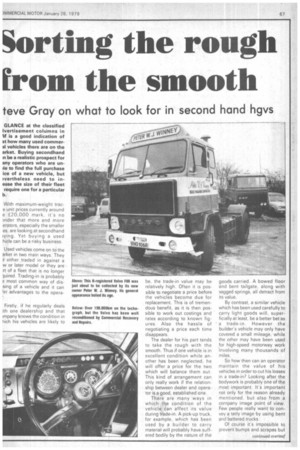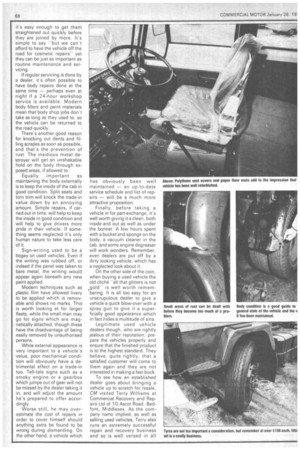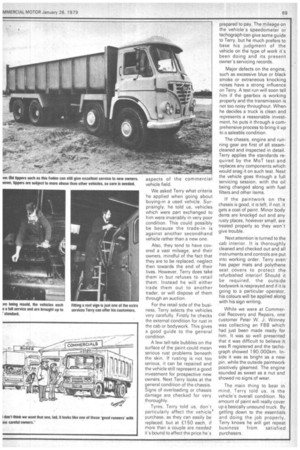Sorting the rough
Page 69

Page 70

Page 71

If you've noticed an error in this article please click here to report it so we can fix it.
from the smooth•
teve Gray on what to look for in second hand hgvs
GLANCE at the classified Ivertisement columns in %4 is a good indication of St how many used commeral vehicles there are on the arket. Buying secondhand In be a realistic prospect for any operators who are unIle to find the full purchase ice of a new vehicle, but :vertheless need to inease the size of their fleet require one for a particular b.
With maximum-weight trac e unit prices currently around e £20,000 mark, its no )nder that more and more erators, especially the smaller es, are looking at secondhand lying. Yet buying a used hide can be a risky business.
Used vehicles come on to the arket in two main ways. They a either traded in against a w or later model or they are rt of a fleet that is no longer uirecl. Trading-in is probably P. most common way of dissing of a vehicle and it can ler advantages to the opera
Firstly. if he regularly deals ith one dealership and that impany knows the condition in hich his vehicles are likely to be, the trade-in value may be relatively high. Often it is possible to negotiate a price before the vehicles become due for replacement. This is of tremendous benefit, as it is then possible to work out costings and rates according to known figures. Also the hassle of negotiating a price each time disappears.
The dealer for his part tends to take the rough with the smooth. Thus if one vehicle is in excellent condition while another has been neglected, he will offer a price for the two which will balance them out. This kind of arrangement can only really work if the relationship between dealer and operator is a good, established one.
There are many ways in which the condition of the vehicle can affect its value during trade-in. A pick-up truck, for example, which has been used by a builder to carry material will probably have suffered bodily by the nature of the goods carried. A bowed floor and bent tailgate, along with sagged springs, all detract from its value.
By contrast, a similar vehicle which has been used carefully to carry light goods will, superficially at least, be a better bet as a trade-in. However the builder's vehicle may only have covered a small mileage, while the other may have been used for high-speed motorway work involving many thousands of miles.
So how then can an operator maintain the value of his vehicles in order to cut his losses in a trade-in? Looking after the bodywork is probably one of the most important. It's important not only for the reason already mentioned, but also from a company image point of view. Few people really want to convey a tatty image by using bent and battered trucks.
Of course it's impossible to prevent bumps and scrapes but continued overleaf It's easy enough to get them straightened out quickly before they are joined by more. It's simple to say "but we can't afford to have the vehicle off the road for cosmetic repairs" yet they can be just as important as routine maintenance and servicing.
If regular servicing is done by a dealer, it's often possible to have body repairs done at the same time — perhaps even at night if a 24-hour workshop service is available. Modern body fillers and paint materials mean that body shop jobs don't take as long as they used to, so the vehicle can be returned to the road quickly.
There's another good reason for knocking out dents and filling scrapes as soon as possible, and that's the prevention of rust. The insidious metal destroyer will get an unshakable hold on the body through exposed areas, if allowed to.
Equally important as maintaining the body externally is to keep the inside of the cab in good condition. Split seats and torn trim will knock the trade-in value down by an annoying amount. Simple repairs, if carried out in time, will help to keep the inside in good condition and will help to give drivers more pride in their vehicle. If something seems neglected it's only human nature to take less care of it.
Sign-writing used to be a bogey on used vehicles. Even if the writing was rubbed off, or indeed if the panel was taken to bare metal, the writing would appear again beneath any new paint applied.
Modern techniques such as plastic film have allowed livery to be applied which is removable and shows no marks. This' is worth looking at for larger fleets, while the small man may go for signs, which are magnetically attached, though these have the disadvantage of being easily removed by unauthorised persons.
While external appearance is very fl-iportant to a vehicle's value, poor mechanical condition will obviously have a detrimental effect on a trade-in too. Tell-tale signs such as a smoky engine or a gearbox which jumps out of gear will not be missed by the dealer taking it in, and will adjust the amount he's prepared to offer accordingly.
Worse still, he may overestimate the cost of repairs in order to cover himself should anything extra be found to be. wrong during dismantling. On the other hand, a vehicle which has obviously been well maintained — an up-to-date service schedule and list of repairs — will be a much more attractive proposition.
Finally, before taking a vehicle in for part-exchange, it's well worth giving it a clean, both inside and out as well as under the bonnet. A few hours spent with a bucket and sponge on the body, a vacuum cleaner in the cab, and some engine degreaser will work wonders. Remember, even dealers are put off by a dirty looking vehicle, which has a neglected look about it.
On the other side of the coin, when buying a used vehicle the old cliché "all that glitters is not ,gold" is well worth remem'bering. It is all too easy for an unscrupulous dealer to give a vehicle a quick blow-over with a spray gun to give it a superficially good appearance which in fact hides a multitude of sins.
Legitimate used vehicle dealers though, who are rightly jealous of their reputation, prepare the vehicles properly and ensure that the finished product is to the highest standard. They believe, quite rightly, that a satisfied customer will come to them again and they are not interested in making a fast buck.
To see how an established dealer goes about bringing a vehicle up to scratch for resale, CM visited Terry Williams at Commercial Recovery and Repairs Ltd of 10 Ascot Road, Bedfont, Middlesex. As the company name implied, as well as selling used vehicles, Terry also runs an extremely successful repair and recovery business and so is well versed in all aspects of the commercial vehicle field.
We asked Terry what criteria he applied when going about buying-in a used vehicle. Surprisingly, he told us, vehicles which were part exchanged to him were invariably in very poor condition. This could possibly be because the trade-in is against another secondhand vehicle rather than a new one.
Also, they tend to have covered a vast mileage, and their owners, mindful of the fact that they are to be replaced, neglect then towards the end of their lives. However, Terry does take them in but refuses to retail them. Instead he will either trade them out to another trader, or will dispose of them through an auction.
For the retail side of the business, Terry selects the vehicles very carefully. Firstly he checks the external condition for rust in the cab or bodywork. This gives a good guide to the general condition.
A few tell-tale bubbles on the surface of the paint could mean serious rust problems beneath the skin. If rusting is not too serious, it can be repaired and the vehicle still represent a good investment for prospective new owners. Next Terry looks at the general condition of the chassis. Signs of overloading or chassis damage are checked for very thoroughly.
Tyres, Terry told us, don't particularly affect the vehicle' purchase, as they can easily be replaced, but at £150 each, if more than a couple are needed its bound to affect the price he's prepared to pay. The mileage on the vehicle's speedometer or tachograph can give some guide to Terry, but he much prefers to base his judgment of the vehicle on the type of work it's been doing and its present owner's servicing records.
Major defects on the engine, such as excessive blue or black smoke or extraneous knocking noises have a strong influence on Terry. A test run will soon tell him if the gearbox is working properly and the transmission is not too noisy throughout. When he decides a truck is clean and represents a reasonable investment, he puts it through a comprehensive process to bring it up to a saleable condition.
The chassis, engine and running gear are first of all steamcleaned and inspected in detail. Terry applies the standards required by the MoT test and replaces any components which would snag it on such test Next the vehicle goes through a full servicing session, with the oil being changed along with fuel filters and other items.
If the paintwork on the chassis is good, it is left, if not, it gets a coat of paint. Minor body dents are knocked out and any rusty places, however small, are treated properly so they won't give trouble.
Next attention is turned to the cab interior. It is thoroughly cleaned and checked out and all instruments and controls are put into working order. Terry even has paper mats and polythene seat covers to protect the refurbished interior! Should it be required, the outside bodywork is resprayed and if it is going to a particular operator, his colours will be applied along with his sign writing.
While we were at Commercial Recovery and Repairs, one customer Peter W. J. Winney was collecting an F88 which had just been made ready for him. It was so well presented that it was difficult to believe it was R registered and the tachograph showed 190,000km. Inside it was as bright as a new pin, while the outside paintwork positively gleamed. The engine sounded as sweet as a nut and showed no signs of wear.
The main thing to bear in mind, Terry told us, is the vehicle's overall condition. No amount of paint will really cover up a basically unsound truck. By getting down to the essentials and doing the job properly, Terry knows he will get repeat
business from satisfied purchasers.












































































































